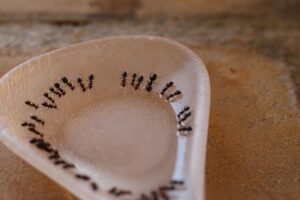
Sugar ants are tiny annoying insects and stubborn household bugs.
Sugar ants are common during warm seasons when they come out of their nests to search for food.
In this post, I’ve discussed the 5 effective ways on how to get rid of the sugar ants.
How to Get Rid of Sugar Ants
You’ll mainly see sugar ants in the yard, under rocks, on trees, and if you are not careful, in your home. They are mainly attracted to sugary foods and scraps and they will do anything to gain entry into your home to find them.
These insect’s body size allows them to gain entry into your home through the tiniest spaces. Sugar ants can be extremely annoying to most homeowners. Let’s get into the details of how to get rid of sugar ants once and for all:
A. Natural Methods
1. Keep your house clean, especially the kitchen
The typical sugar ant diet consists of anything they can find lying around in your home. Even a tiny crumb from a snack you hastily devoured might be enough to attract hundreds of ants to your home. Always keep your home clean and surfaces free from food scraps that might attract ants. Make sure you clean dirty dishes in the sink and dispose of your trash regularly. Wipe down the counters thoroughly, dust your shelves, vacuum your floors, and have professionals clean the carpet regularly.
2. Soapy Water
Dishwashing soap and other detergents can double up as pest killers in various circumstances. Just mix some soap with water and pour it into a spray bottle. Soap has a certain scent that acts as a deterrent against sugar ants and when sprayed directly on the ants, it can kill them.
3. Store your food properly
Leaving your food open and exposed is almost like sending the sugar ants an invitation into your home. Keep your perishable food items such as fruits and vegetables safely locked away in the fridge where the ants can’t access them. Your non-perishable food items such as cereals should be stored in airtight containers then kept in cabinets where the ants can’t get to.
4. Use Vinegar
Vinegar can be an effective ant deterrent when used creatively. It contains acetic acid which is a powerful ant deterrent and also removes the scent of ant trails preventing other ants from using the same route to access your home. You just need to combine equal parts vinegar and water into a spray bottle and blitz the areas you’ve either spotted ant activity before or where you want to ensure sugar ants never get to, such as kitchen surfaces.
The only drawback with vinegar is that it only keeps ants at bay when its scent is still strong, which doesn’t last that long. You will need a full spray bottle if you choose to use this method for a while.
5. Coffee Grounds
If you are a coffee lover, you will love this one! Instead of getting rid of your coffee grounds, you can use them to repel sugar ants. Ants hate the burning acidity and smell of coffee grounds. You can sprinkle them around your home or in areas where you want to repel ants, such as near pet bowls.
6. Cloves, Bay Leaves or Garlic
The compounds responsible for the strong smell in bay leaves and cloves are also highly effective for repelling sugar ants. Garlic also has a strong odor that throws ants off their scent trails and confuses them. Lay out bay leaves and whole cloves along baseboards and other areas where you want to repel ants.
7. Homemade ant repellent
You can easily make your own insect repellent at home by combining water with peppermint or lavender essential oils and spraying it on ant infested areas.
8. Homemade ant trap
You can easily make an ant trap by smearing a sweet and sticky substance like honey or corn syrup on a plate and placing it in areas where you know sugar ants have invaded. The sugar attracts ants to the plate but since it’s sticky, the ants will be stuck giving you a chance to annihilate them.
B. Chemical Methods
1. Ant killer sprays and insecticides
There are commercial ant killer sprays or insecticides that you can use to kill ants in your home. However, remember that such products contain toxic chemicals that can be harmful to you, your kids or pets. Be careful when using them.
2. Ant Bait
This is where you use a poisonous bait disguised as ant food to destroy an entire colony. The idea is to trick the ants into carrying the bait back to their colony as food. Once the ants eat the bait, they’ll slowly begin to die. Most ant baits contain borax or boric acid which is a slow-acting ant poison.
If you have tried all these methods and failed( which is highly unlikely), your next best option is to hire a professional exterminator to come in and deal with the ant problem for you once and for all.